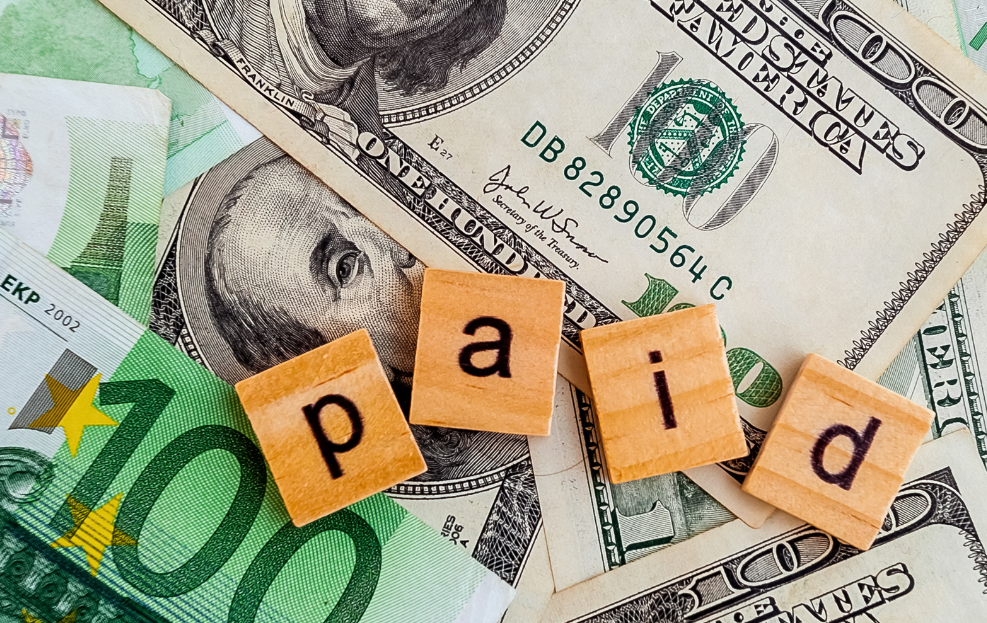
How to make your first sale: Tips for new businesses
You’ve got the idea, the product, and the motivation, but
✓ No credit card needed ✓ All features are available with our Free plan
✓ No credit card needed
✓ All features are available with our Free plan

If you’ve accepted not getting paid on time as just “part of doing business,” it’s time to change that mindset. The truth is, you can train your clients to pay on time by setting clear expectations, enforcing your terms, and following up the right way.
Getting paid on time isn’t about luck; it’s about having a clear and structured system. In this guide, we will show you how to vet clients and quickly spot the risky ones, how to set clear payment terms that leave no room for confusion, and how to follow up effectively so you’re not stuck chasing unpaid invoices.
Let’s start by figuring out how to tell the difference between clients who pay on time and those who are likely to give you a headache
Whether you’re just starting a small business or you own one, before working with a new client, ensure they’re financially reliable. Here’s how to protect yourself from clients who aren’t trustworthy:
Taking the time to vet potential clients reduces your risk of not getting paid on time and guarantees you work with businesses that respect your time and effort.
Additional resource: 9 small things you can do for your business.
Want to know how to get paid on time? It all starts with a well-written agreement because it clearly states your payment expectations. Here’s how to protect yourself from not getting paid on time:
Further reading: How to track expenses as a small businesses.
On a final note, setting clear payment terms before you start working with a client ensures you create a structured agreement that helps you get paid on time.
When it comes to how to get paid on time, strong relationships and clear communication matter just as much as contracts and invoices. If you’re professional and easy to work with, clients will be more likely to prioritize your payments. Here’s how you can stay professional and avoid the frustration of not getting paid on time:
Remember, when clients see you as organized and easy to work with they’re more likely to prioritize your invoices.
Additional reading: 7 tips to make your small business stand out.
One of the most common reasons for a late invoice payment is the wrong invoice details. Make sure that every detail from your company’s details to your client’s details to your payment instructions are all correct.
An invoice is meant to represent a transaction but if the details of the transaction are wrong, it won’t work.
Read over the invoice carefully before you send it. If can be hard to correct information on an invoice like incorrect prices or the wrong due date, once an invoice is sent.
Make sure that your invoice is easy to read before you send it.
If the customer can’t clearly see what they need to pay you, they could pay you incorrectly.
Asking for a deposit before you begin the job is a common practice if you invoice large amounts.
Even if the client fails to pay you, you’ll still have some of what they owe you to help you cover expenses before you get the rest of your money.
You can also add several payment milestones throughout the project. This means that if the client fails to meet one, you can halt the project before you spend too much time and money on the project.
It’s also common for some types of businesses to ask for full payment before starting the project.
This is the safest method for ensuring you get paid but if its not common practice in your industry, you might want to avoid it so you don’t come across as difficult to work with.
The most important lesson to always keep in mind is that you should always look after your customers. That doesn’t mean letting them take advantage of you but you won’t gain anything by coming across as hard to work with.
You can request deposits from clients in Bookipi Invoice web app and track payments in one spot.
One simple way to encourage your customers to pay your invoices faster is to issue your invoice immediately after you’ve completed the job.
When you issue the invoice straight away, the project you’ve completed is fresh in the mind of your client.
They’re more likely to pay you earlier than the due date of the invoice. Clients are less likely to question the work you’ve done for them.
Sending invoices straight away will also demonstrate that you’re a professional business operator and that you shouldn’t be taken advantage of. Easily send invoices using Bookipi Invoice on web or mobile app.
You’re also less likely to make mistakes on the invoice about the details of the project if you issue it straight after completing your work.
You might want to receive the payment in a certain format. However, that might not be an easy way for your client to pay you.
At the end of the day, it is better that you get paid than not get paid because you wanted them to pay you a certain way.
Offer multiple ways for clients to pay you including card payments.
You can make it known to them that you would prefer them to pay you in a certain way because they’ll generally be happy to pay you that way. You can even offer a discount if they pay you in a certain format to encourage them to use that payment method.
If you want your clients to pay earlier than the due date, you can offer a discount if they pay in advance of the due date.
It doesn’t have to be a massive discount, even just two percent can be enough to motivate your client to pay earlier.
If most of your clients are small businesses, a good portion of them will use any opportunity for a discount that they can get. Including an incentive will also encourage clients to use you again in the future.
Remember that business is all about building good relationships and offering something positive like a discount can be worth it in the long-term.
If you really want to deter your clients from not paying invoices on time, you can include a penalty for all payments made after the due date.
The threat of having to pay more if they pay late is usually enough to ensure that clients pay their invoices.
To add late fees, you must clearly write this into the payment instructions or terms of conditions on your invoice.
For big jobs, you’ll want to write this into your contract. It’s best practice to verbally let you client know about late fees before they make a formal order with you. You can specify late fees in advance on pro forma invoices, estimates or business proposals.
Springing late fees on clients without having proof that it was clearly indicated before a transaction began, doesn’t help your business look professional.
Don’t wait for your clients to pay you. Follow up a late payment from clients as soon as an invoice is overdue.
You can and should ask clients for payment if an invoice is overdue. Send clients an email even if it’s a day after the due date. You provided the services/products and they need to pay you for it. Be polite and direct with the client while doing this because at the end of the day, you don’t want to appear unprofessional.
There might be an issue with the invoice which is preventing them from paying you so don’t automatically assume that the client is at fault.
One of the biggest challenges for small business owners is not getting paid on time, which can disrupt cash flow. Here are seven practical tips to help you stay on top of your payments.
Accounting software like Bookipi helps you automate the invoicing process and reduce manual errors by setting up recurring invoices and tracking payments in real time. You can also grab our free templates to quickly create professional invoices without starting from scratch.
Instead of manually chasing clients for payments, let automated reminders do the work by scheduling alerts before and after payment due dates.
Make it easy for clients to pay you by offering multiple options, such as, bank transfers (ACH or wire), credit and debit card payments, or online payment platforms like PayPal or Stripe.
Invoice factoring means a company buys your unpaid invoices at a discount and collects payment directly from your clients. While invoice financing means you borrow money against outstanding invoices but remain responsible for collecting payment.
Only offer credit to reliable clients to reduce the risk of not getting paid on time. Set strict credit control policies by defining who qualifies for extended payment terms and establishing a clear escalation process for overdue invoices.
Set up a system to monitor your incoming payments and identify clients who regularly pay late. This system allows you to adjust their terms accordingly before it’s too late.
Further reading: 10 ways to use AI for small businesses.
For new clients, request an upfront deposit (e.g., 50% upfront, 50% on completion for services) or milestone-based payments to reduce the risk of clients disappearing without paying.
Summing it up, late payments are a common problem for small businesses, but by using the right tools and clear processes you can stay profitable and ensure timely payments.
Read next: 6 bookkeeping tips for small businesses.
Even after setting clear contracts and sending your invoices on time, some clients will still miss payment deadlines. To ensure you get paid on time without damaging your client relationships, follow these best practices:
A week or few days before your payment is due send a polite email that restates the invoice due date and amount, and a copy of your invoice as an attachment.
If the invoice passes the due date without payment, send a more serious follow-up that clearly states that the invoice is overdue and specify any late payment penalties or interest charges.
If your formal reminder is ignored, use invoice apps to keep the pressure on with weekly follow-ups that re-emphasizes the amount due, payment terms.
Avoid aggressive or threatening language, as this can harm relationships and make your clients less likely to cooperate. Instead, be firm but polite by reinforcing your payment terms and staying open to a conversation.
If a client is genuinely struggling, offering a payment plan such as smaller installments can help you recover your money while maintaining a positive business relationship.
The key to getting paid on time is consistent follow ups and having a structured approach ensures you recover payments without damaging client relationships.
Additional resources: 15 invoicing mistakes to avoid with your small business.
No matter how well you run your business, not getting paid on time is a reality you’ll likely face at some point. Here’s a step-by-step guide on how to get paid on time, even when clients aren’t cooperating.
Strengthening your payment terms can be a great way to boost your financial stability and peace of mind. Start by reviewing your contracts and invoices to see if you can shorten payment deadlines. It’s also a good idea to have clients confirm they’ve read your payment terms before you begin working together. This helps ensure everyone is on the same page from the start.
To further protect your business, consider implementing a few more strategies. For instance, you might run credit checks on new clients and set limits for those who pose a higher risk. Payment insurance can also be a lifesaver for large invoices, providing compensation if a client defaults. Asking for advance payments or deposits can help secure part of your payment upfront, while setting up direct debit mandates for recurring clients can make the payment process smoother and more reliable.
Read next: 5 ways to take your small business to the next level.
To wrap it up, If you’re not getting paid on time, take action immediately! The longer an invoice sits unpaid, the harder it becomes to collect. Additionally, stay firm but professional by sending reminders and taking legal action when necessary.
Explore related articles:

You’ve got the idea, the product, and the motivation, but

The same way email and spreadsheets became must-know tools at

Whether you realize it or not, artificial intelligence integration is